Russia's MoD lies again: evidence of destroyed Russian helicopters found. PHOTOS
New evidence of a May 14 attack on the T4 airbase in Syria, which destroyed Russian helicopters and other military equipment, has been released.
Censor.NET reports referring to another investigation by Conflict Intelligence Team.On May 24, Stratfor analysts published satellite images of the T4 airbase in Syria, also known as the Tiyas airbase. They claim the pictures shows four Russian Mi-24 helicopters destroyed by an ISIS attack on May 14.
The Russian Ministry of Defense has denied this information, stating that all Russian helicopters continue to perform their tasks, while the satellite imagery shows traces of a several months old fighting.
However, there is evidence that the T4 airbase indeed was damaged on May 14 and that Russian helicopters and probably other military vehicles were at this airbase.
Was there an explosion?
The first report of four Russian helicopters and 20 ammunition trucks having been destroyed at the T4 airbase came from ISIS-linked Amaq agency. On the same day, this information was confirmed by pro-Assad sources, although they claimed the explosion was caused by a "human error", not an ISIS attack.
As noted by Twitter user @obretix, traces of the explosion appeared in May on publicly available Landsat satellite imagery:
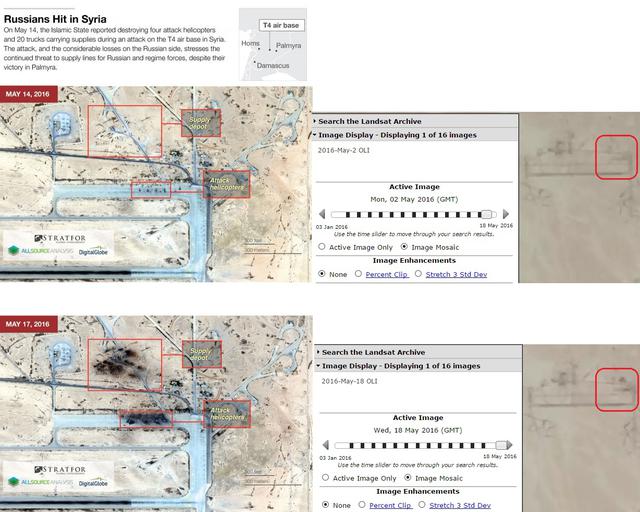
Top left: Stratfor satellite image, May 14; top right: Landsat satellite image, May 2; bottom left: Stratfor satellite image, May 17; bottom right: Landsat satellite image, May 18
"Thus, apparently there indeed was an explosion at the T4 airbase. However, the Stratfor article did not present evidence that the destroyed helicopters were indeed Russian and not Syrian (Mi-24s are in service of both countries). However, our team has found evidence of the presence of Russian helicopters and probably other military hardware at T4 airbase in spring 2016," the investigation notes.
Russian helicopter
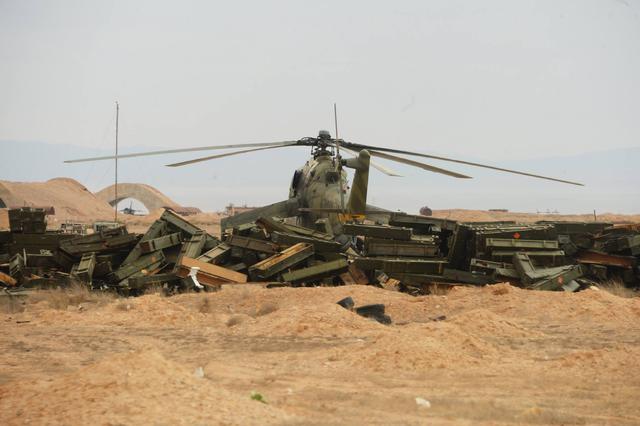
Photo: Mikhail Voskresenskiy, Ria Novosti
Upon the examination of the helicopter's image, it becomes clear that it is indeed a RuAF (not SyAAF) helicopter.
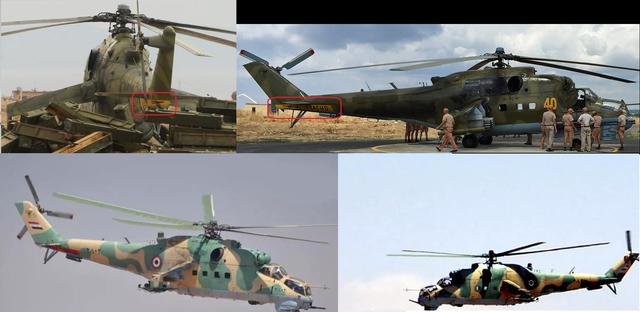
Top left: Mi-24 helicopter at the T4 airbase; top right: RuAF Mi-24 at the Hmeimim airbase (source); bottom: SyAAF Mi-25s (export version of Mi-24, source)
We have geolocated the helicopter in the image at the exact same position as the helicopters in the Stratfor's May 14 satellite imagery.
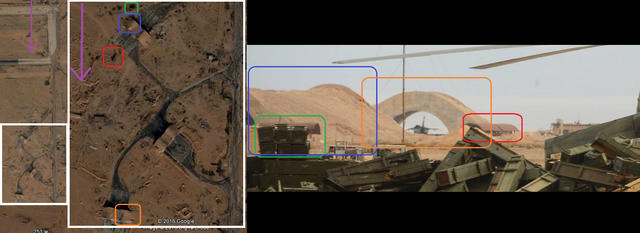
Camera direction marked with purple arrow (Google Maps link)
To the south of the T4 airbase (in the camera direction) there is a mountain ridge also visible in the RIA Novosti photo:

Top: RIA Novosti photo; bottom: Google Earth landscape model (Google Maps link)
The RIA Novosti photo also shows ammunition crates to the north of the helicopter, also visible in the Stratfor's image:
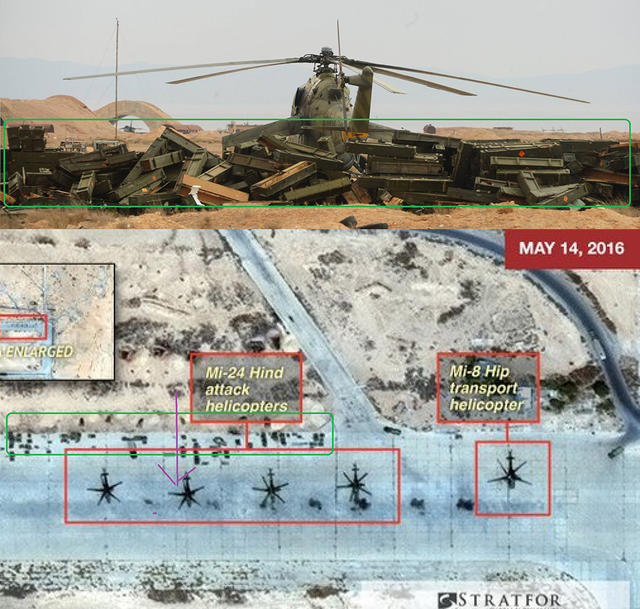
Ammunition crates in the RIA Novosti photo and in the Stratfor's image marked in green, camera direction marked with purple arrow
"Thus, it is evident that at least on March 21 a Russian Mi-24 helicopter was at the same position as the helicopters (later destroyed by explosion) in the Stratfor's May 14 satellite imagery. Most likely, these were indeed Russian helicopters that were damaged by the explosion," the investigators note.
Smerch MRLS at the T4 airbase
Another photo, also taken by Mikhail Voskresenskiy on March 21 at the T4 airbase, is marked "Uragan multiple rocket launcher systems of the Syrian Arab Army (SAA) near Palmyra."
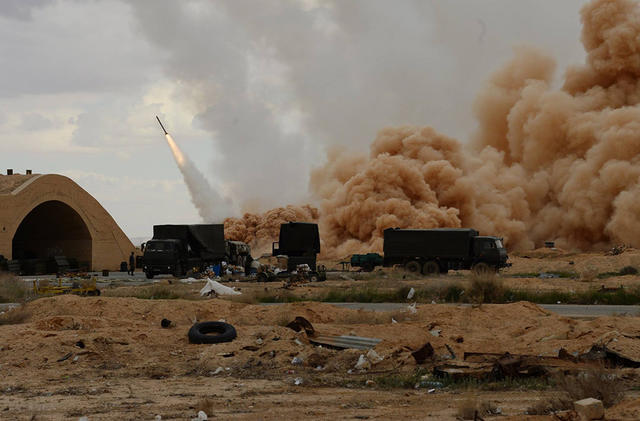
"However, a high resolution image shows a rocket with notable white markings, which, we believe, is not an Uragan rocket, but a Smerch rocket," the article notes.
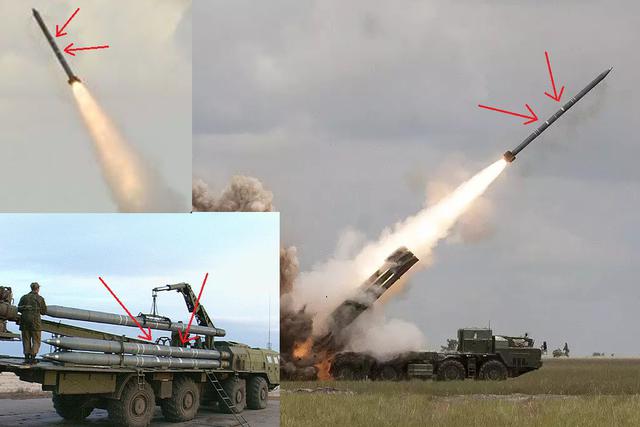
Top left: part of the RIA Novosti photo: source for bottom left photo; source for right photo
Earlier, a Smerch MRLS with a Russian crew (and the same white markings on the rockets) was spotted in Latakia

The fact that the RIA Novosti image shows a Smerch volley and not an Uragan volley is also confirmed by the thick white smoke.
Uragan and Grad rokets use double-based solid rocket fuel (solid solution of nitrocellulose in low-volatility solvent) which produces almost no smoke while burning.
However, Smerch rockets use solid mixture rocket fuel (mechanical mixture of special purpose rubber with aluminum and ammonium perchlorate) which produces a thick white smoke while burning. We can see this thick white smoke in the RIA Novosti image.
Examples: Uragan volley:
Grad volley:
Smerch volley:
Thus, apart from Russian helicopters, the Palmyra offensive was probably also supported by Russian rocket artillery from the T4 airbase. It also could have been damaged in the explosion.
Was the explosion an ISIS attack?
There is some doubt about it. For instance, Fox News's U.S. intelligence sources claim that the Russian helicopters could have been destroyed in an accidental fuel tank explosion. Given the number of ammunition crates scattered near the helicopters, this seems a distinct possibility.
Moreover, the Stratfor's satellite imagery shows no visible damage aside from the explosions and no artillery craters: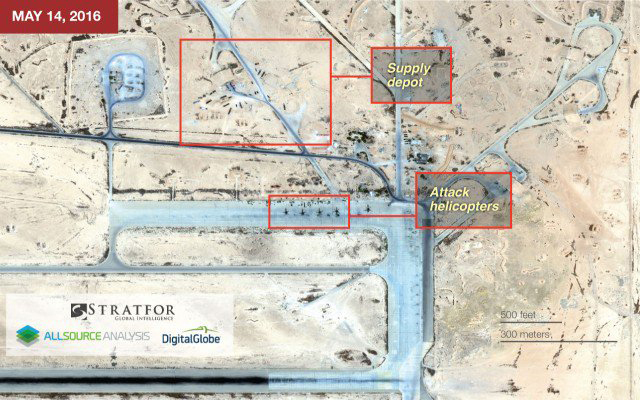
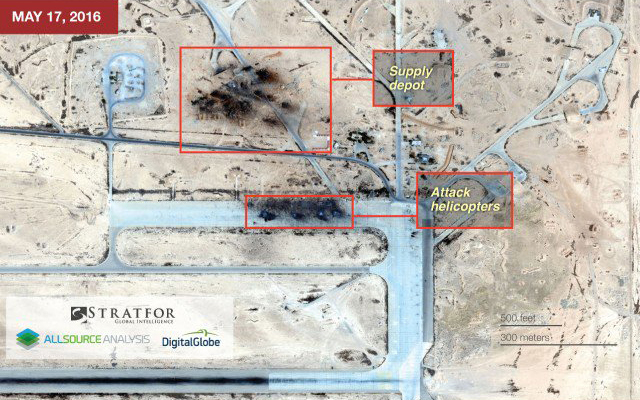
Were Russian soldiers killed?
"As of now, there is no evidence of Russian soldiers being killed in the T4 airbase explosion. In particular, there are no social media traces, i.e. mourning posts from friends and relatives that are common for dead Russian soldiers and mercenaries. However, we continue monitoring social networks for information on killed Russian soldiers," the investigators say.
Conclusions
- apparently there indeed was an explosion at the Syrian T4 airbase on May 14 which destroyed several helicopters and, possibly, other military hardware;
- Russian helicopters and possibly Smerch rocket systems have been present at the Syrian T4 airbase since at least late March 2016;
- most likely these were indeed Russian helicopters (not Syrian government helicopters) that were destroyed in the explosion;
- the explosion's cause is unknown, but there is doubt it was caused by an ISIS attack;
- currently there is no evidence of Russian soldiers being killed in the incident.
